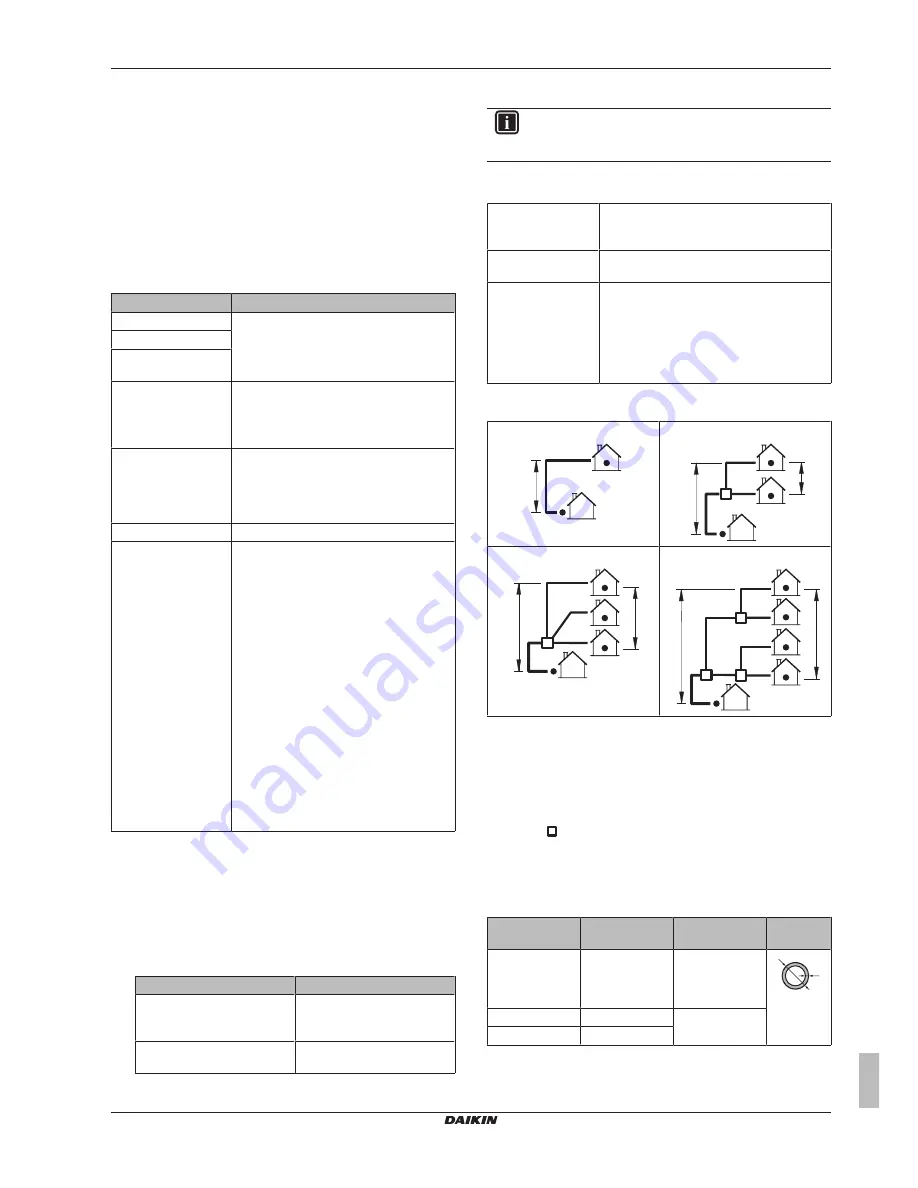
5 Preparation
Installer reference guide
9
RZQG71~Y1 + RZQSG100~Y1
Split system air conditioners
4P385522-1A – 2016.10
Reuse not allowed
You may not reuse existing piping in the following cases:
▪ When the compressor in the old installation had problems
(example: breakdown).
Possible consequence:
oxidised coolant
oil, scale residue and other adverse effects.
▪ When the indoor and outdoor units were disconnected from the
piping for a long time.
Possible consequence:
water and dirt in
the piping.
▪ When the copper piping is corroded.
Reuse allowed
In other cases than above, you may reuse existing piping but keep
the following in mind:
Item
Description
Piping diameter
Must comply with requirements. See
"5.3.2 Refrigerant piping requirements" on
page 9
.
Piping material
Piping length and
height difference
Piping insulation
If deteriorated, must be replaced.
Must comply with requirements. See
"5.3.3 Refrigerant piping insulation" on
page 12
.
Flare connections
May not be reused. Make new ones to
prevent leaks. See
"6.4.3 Guidelines when
connecting the refrigerant piping" on
page 15
and
"6.4.5 To flare the pipe
end" on page 15
.
Welded connections
Must be checked for gas leaks.
Cleaning pipes
If the following conditions are met, you do
not have to clean the pipes. Otherwise, you
must clean the pipes, or install new ones.
Conditions:
▪ The total one‑way piping length is <50 m.
This means:
▪ Pair: L1<50 m
▪ Twin and triple: L1+L2<50 m
▪ Double twin: L1+L2+L4<50 m
▪ You pumped down the old system
correctly. This means:
▪ Operated the unit continuously for
30 minutes in cooling mode.
▪ Pumped down the system.
▪ Removed the old units.
▪ Piping is not contaminated (see below).
To check if piping is contaminated
You must check if existing piping is contaminated because using
piping with deteriorated oil will cause compressor breakdown.
Prerequisite:
You need an oil checking reference card. This is
available from your dealer.
1
Put some residual oil from the piping on a piece of white paper.
2
Compare the colours:
If the oil colour is…
Then…
Identical to or darker than the
circled colour on the reference
card
You must clean the existing
piping, or install new piping.
Lighter than the circled colour
on the reference card
You can reuse the piping
without cleaning.
5.3.2
Refrigerant piping requirements
INFORMATION
Also read the precautions and requirements in the
"General safety precautions" chapter.
When connecting multiple indoor units to the outdoor unit, mind the
following:
Refrigerant branch kit One or more refrigerant branch kits are
required. See
"4.3.1 Possible options for the
outdoor unit" on page 7
.
Upward and
downward piping
Perform upward and downward piping only
on the main piping line (L1).
Branch pipes
▪ Install the branch pipes horizontally (with a
maximum inclination of 15°) or vertically.
▪ Make the length of the branch pipes to the
indoor units as short as possible.
▪ Try to keep length of the branch pipes to
the indoor units equal.
Definitions: L1~L7, H1, H2
Pair
(a)
H1
L1
Twin
(a)
H1
H2
L1
L2
L3
Triple
(a)
L2
L3
L4
H1
H2
L1
Double twin
(a)
H1
H2
L1
L2
L3
L4
L5
L6
L7
(a)
Assume that the longest line in the illustration corresponds
with the actual longest pipe, and the highest unit in the
illustration corresponds with the actual highest unit.
L1
Main piping
L2~L7
Branch piping
H1
Height difference between the highest indoor unit and the
outdoor unit
H2
Height difference between the highest and the lowest
indoor unit
Refrigerant branch kit
Refrigerant piping material
▪
Piping material:
Phosphoric acid deoxidised seamless copper.
▪
Piping temper grade and thickness:
Outer diameter
(Ø)
Temper grade
Thickness (t)
(a)
6.4 mm (1/4")
9.5 mm (3/8")
12.7 mm (1/2")
Annealed (O)
≥0.8 mm
t
Ø
15.9 mm (5/8")
Annealed (O)
≥1.0 mm
19.1 mm (3/4")
Half hard (1/2H)
(a)
Depending on the applicable legislation and the unit's
maximum working pressure (see "PS High" on the unit
name plate), larger piping thickness might be required.










































